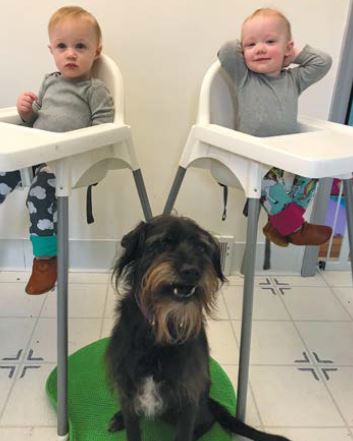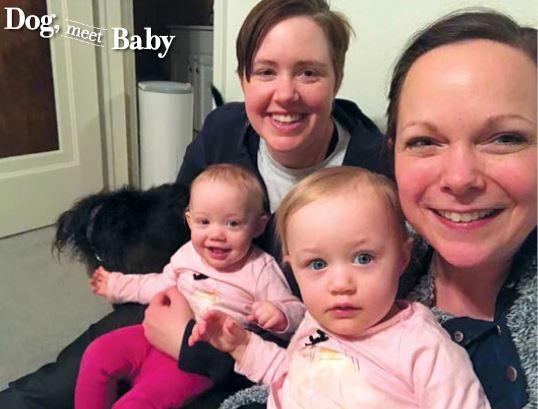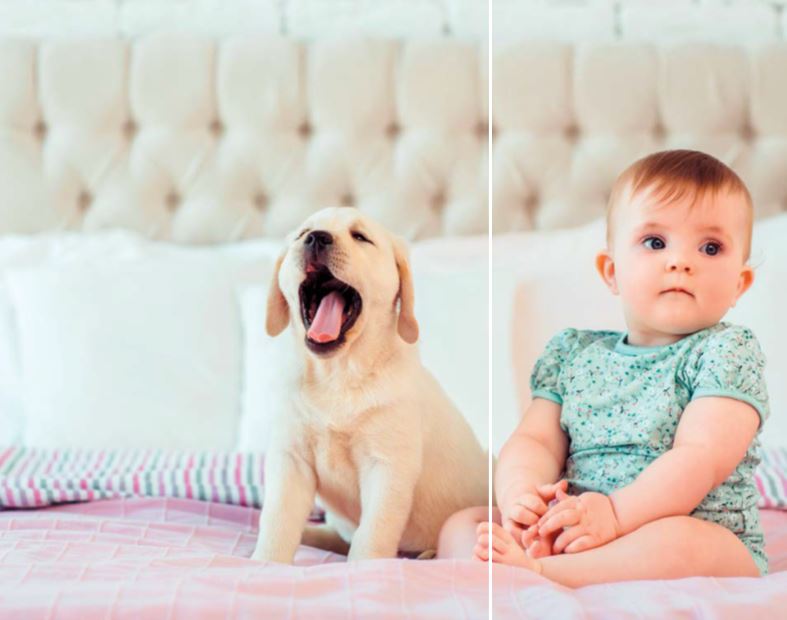For onlookers and people passing by, it may have been an awkward sight. But for Anna Berowski and Meghan Davitt, it was all part of their plan.
In the months before their twin girls were born, the couple would walk their dog, Avery, along the sidewalks of their Minneapolis neighborhood while also pushing a stroller — an empty stroller.
Avery, their 6-year-old mixed-breed rescue, didn’t like kids.
Her dislike of children ran deep, so much so that when kids came to their home, Avery had to be kenneled. When Avery was out on a walk and encountered children, the couple would take her to the other side of the street or would have to turn around and go the other way.
When Davitt became pregnant with twins, the couple began preparing not just themselves for the arrival of the babies, but Avery as well.
“Avery also resource-guards food and spaces from other dogs,” Berowski said. “She has never done this with adult humans, but we weren’t sure what little kids would be classified as for her.”
Prepare for the arrival
In the months leading up to their daughters’ birth, the couple did what they could to prepare Avery. They let her explore things like baby blankets and toys, and they began working with Kate Anders, a certified dog behavior consultant and trainer, and owner of Pretty Good Dog Training of Minneapolis.
Anders specializes in child-dog conflict cases in and around the Twin Cities, including helping parents prepare their dogs for the arrival of children. While parents may dream of having a dog that immediately adores a new child and becomes a child’s best friend right away, that’s usually not the way things work.
“Our society tends to assume kids and dogs will naturally mesh well,” she said. “But kids and dogs are a lot like oil and water in that they don’t naturally mix together. The combination is just naturally set up for miscommunication: You have young children who tend to stare at faces and dogs that try to avoid direct facial conflict.”
Anders likes to use the oil-and-water analogy to describe the interactions between children and dogs.
“If you adjust them a bit, you can mix them very successfully and build a relationship that is appropriate,” she said. “You just have to add a few extra ingredients to make them into a cake.”
Berowski and Davitt first met Anders at her Dogs and Storks program, a workshop designed to help prospective and expecting parents prepare for a child’s arrival with their dogs in mind. Parents learn basic dog body language, how to handle the homecoming and important safety tips.
Watch for tension points
Anders sees two common problem scenarios when it comes to children and dogs.
The first, which is less frequent, includes bringing a baby home to a dog that becomes upset about the new arrival.
“The dog may act fearful or anxious, but there’s an intensity there that makes the parent uncomfortable,” Anders said. “This is only an issue for a small number of people, but it’s a crisis adjusting to a new baby if your pet is going nuts.”
The second, more common scenario happens when the child becomes more mobile.

“Many dogs adjust initially since the child isn’t really moving around,” Anders said. “But now they see this thing moving — and that can make the dog uncomfortable.”
Terri Derr, founder of Veterinary Behavior Options in Golden Valley, agreed.
Just because a dog adores its owners, that doesn’t mean it will adore their baby, Derr said.
When parents see Internet photos and videos of dogs napping peacefully next to a baby or a baby and dog gently playing together, it can set up unrealistic expectations. (Jessica Shyba’s Momma’s Gone City Instagram feed comes to mind.)
“People want the dog to be the protector (and like everyone), but the dog has no biological way of knowing that this little creature is going to grow up — and is a human being,” Derr said. “Sometimes dogs see the baby as prey and will attack if it seems vulnerable. It’s rare, but it happens. Dogs are still dogs, even though we treat them as family members.”
If you have a dog that has ever shown aggression to a person or has a high prey drive, you might want to consult with a professional pet expert before making any big family changes.
Learn to read your dog
Derr and Anders said understanding your dog’s body language is crucial as it can give you important signals as to how a dog is feeling — happy, unsure, anxious.
Some signs that a dog may be feeling stressed include:
- Flicks his tongue or licks his lips when not eating or expecting a treat;
- Ears go back;
- Looks away to avoid eye contact;
- Starts pacing;
- Avoids the situation;
- Starts panting, gets sweaty paws or sheds excessively.
“If you are introducing a dog to a child for the first time or are ever unsure of how your dog will react, always have the dog on a leash with a responsible adult holding the leash,” Derr said. “If a dog wants to explore, that’s great. But always watch the body language.”
On a day-to-day basis, try to keep both your child and dog comfortable at all times.
Instead of relying on isolation (or punishment) for your pup, consider creating barriers.
Barriers not only help to make the dog feel safe, but can also help parents juggle the safety of both the child and the dog.
“Barriers can be physical, such as a door, a kennel, a gate or even an adult in the middle,” Anders said. “You can also move furniture around depending on your environment and your dog. If you have a coffee table, push it against the couch so the dog can sleep on the couch, but the baby can’t reach or touch the dog.”
If you’re doing tummy time with
your baby, try sitting on the floor with your child on one side and your dog on the other.
Think of it as a relationship that needs continued support and make adjustments when necessary.
“With dogs, it’s not just about safety issues, it’s about developing a relationship,” Anders said. “You want to keep the child safe from the swimming pool, but you don’t want them to be scared of the water. You want both the child and dog to feel that the adult is responsible. You want good things to happen when they are around each other so they can think, ‘I like that other creature.’”

Providing protection
Vivian and Rosie, Berowski and Davitt’s twins, are now a year old. Their dog, Avery, did adapt well to the girls’ arrival, but it wasn’t without a lot of effort.
“Avery still needs some redirecting at times, but I feel more capable of doing it,” Davitt said of the adjustment. “Kate helped us feel that with some adaption, it seemed possible for our anxious dog to coexist and thrive in a home with kids.”
Before Vivian and Rosie were mobile, Avery learned to stay in place on her mat or bed as directed. She even learned to relax next to the girls if they were on their play mat. If the girls were being held, Avery would often come sit close to them, but was easily redirected if she tried to lick or paw at them.
The couple did some follow-up sessions with Anders once their girls were crawling and walking.
“Now that they are more mobile, Avery is comfortable being separated by baby gates as needed,” Berowski said. “Avery sometimes comes in the play room to interact, but these direct interactions are short since we don’t want to give the girls an opportunity to annoy her.”
Life with the twins and the dog has evolved in the past year and will continue to change, of course.
“One thing Kate said that stuck in my mind is that for a time you are protecting the kids from the dog — and then it switches,” Berowski said. “We are very much in the phase where we are protecting the dog from the kids.”
Rachel Brougham is a freelance writer and editor who lives in Minneapolis.

















